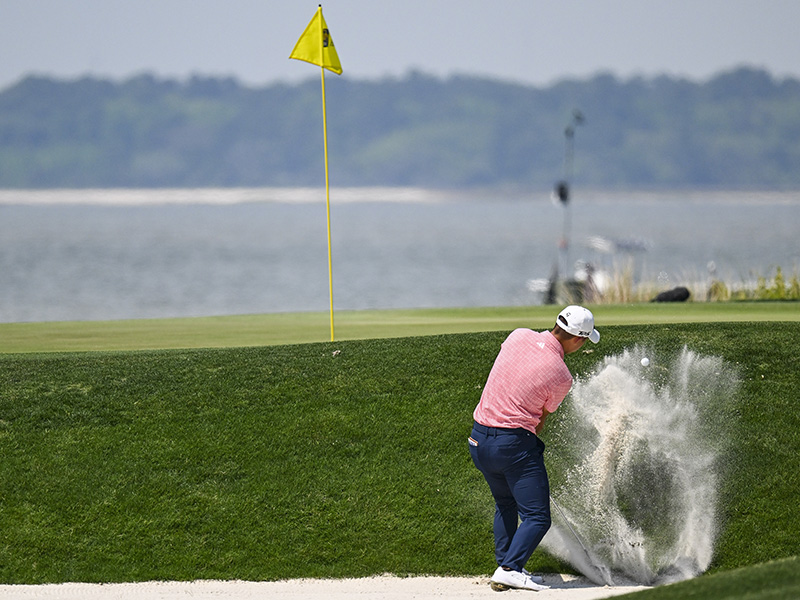'It Was So Embarrassing... I Would Just Hack Away At The Sand Despairingly' – This Fail-Safe Bunker Shot Technique Is A Game-Changer For Amateur Golfers
The number of shots amateur golfers lose due to poorly executed bunker shots is criminal, but all that can change with PGA Pro Joe Ferguson's fail-safe solution


For many amateur golfers, like me, having to hit a bunker shot can conjure a variety of negative emotions.
Some players feel scared of not being able to get out without hacking away over and over again, while others fear the opposite - a knifed strike that sails over the green and into even more trouble.
Sadly, I have fallen into both camps at one time or another. In one specific scenario, I was so embarrassed by my endless hacking in the bunker, with the ball travelling nowhere at all, that I decided to just pick up.
In hindsight, that didn't really help me in the long run. No matter your aversion to the sand traps, it's important to address the issue and find a fail-safe shot that you know will limit the damage to your scorecard and lead to better bunker play.
That might not be your traditional up-and-down, but even giving yourself a shot to get out and a two-putt can seriously limit those big numbers plaguing your round.
Fortunately, PGA Pro and Golf Monthly Staff Writer Joe Ferguson is on hand to help you do just that with this helpful video and article, where he shares his top tips to escape the sand.
How Can I Consistently Get Out Of The Bunker First Time?

Joe has worked in the golf industry for nearly 20 years in a variety of roles. After a successful amateur career being involved in England squads at every age group, Joe completed his PGA degree qualification in 2014 as one of the top ten graduates in his training year and subsequently went on to become Head PGA Professional at Ryder Cup venue The Celtic Manor Resort.
Equipment has always been a huge passion of Joe’s, and during his time at Celtic Manor, he headed up the National Fitting Centres for both Titleist and Taylormade.
Finding the bunker can be infuriating, irrespective of whether you have come up just short with a well-struck approach shot or thinned one straight into the trap. Rather than dwelling on it, it's important to come up with a proactive plan to rectify the situation.
Subscribe to the Golf Monthly newsletter to stay up to date with all the latest tour news, equipment news, reviews, head-to-heads and buyer’s guides from our team of experienced experts.
As you can see in the video above, I have come up short-sided in the greenside bunker, which for a player who isn't confident in the sand can be one of the worst case scenarios.
Still, it's possible to play a sensible shot that will put you back on track and at least give you a putt for your next shot.

The short-sided bunker shot is one of the toughest to get right... especially for amateur golfers who struggle with their confidence in the sand
I like to envisage a small circle around the ball, giving the appearance of a fried egg. This creates the appearance of a fried egg, with the ball as the yolk, but you can also think of the ball sitting on its own little island.
It would be sensible to take the target out of focus when playing this shot, as anywhere on the green is good, but in fairness I actually want to take the ball out of focus also.
Instead, my main goal with this shot is to slap the island of sand, landing it as close to the hole as I can. If you get tentative with the shot, the sand that you hit will remain in the bunker, which means your ball is likely to succumb to the same fate.
What Speed Should My Swing Be For A Bunker Shot?

Speed is crucial through the shot, so commit don't back out or you might find yourself back in the same spot again
Speed is underrated in bunkers... you need the pace in your swing to get the ball out!
Therefore, I would suggest hitting this type of shot quite hard and really committing to the swing. To counter-act this slightly, it's key that you open the clubface slightly to ensure the ball pops up and you don't thin it with the leading edge.
Due to the bounce on your wedges, and the speed you are generating in the swing, the club will enter at the back of the island and come out the other side having propelled your ball high up into the air.
What If The Ball Is Plugged In The Bunker?

As I describe it in the video, a plugged lie in the bunker when short-sided is deeply unpleasant. The ball is sitting below the surface level of the sand and we therefore need to get the club under the ball to spring it out.
Plenty of amateur golfers will see this scenario and instantly try to manufacture a position that 'helps' the ball into the air. That is the worst thing you can do in this situation.
While I still want you to generate the speed, I am not too worried about throwing the sand forwards with this shot. Instead, I want you to drill the club into the sand as hard and as fast as you can, and if at all possible leave the club there after impact (as seen in the video above).
You actually need to hit down to make the ball go up, but with these fail-safe techniques you should have no problem getting the ball airborne out of the bunkers and creating opportunities to save your score.

Baz joined Golf Monthly in January 2024, and now leads the instruction section across all platforms - including print and digital. Working closely with Golf Monthly's Top 50 Coaches, he aims to curate and share useful tips on every aspect of the game - helping amateurs of all abilities to play better golf. Baz also contributes weekly to the features section, sharing his thoughts on the game we love and the topics that matter most. A member at Sand Moor Golf Club in Leeds, he looks forward to getting out on the course at least once a week in the pursuit of a respectable handicap.
Baz is currently playing:
Driver: Benross Delta XT
3-Wood: Benross Delta XT
Hybrid: TaylorMade Stealth 4 Hybrid
Irons: Benross Delta XT 5-PW
Wedges: TaylorMade RAC 60, Callaway Jaws MD5 54
Putter: TaylorMade Spider Tour